Strategic Leadership in Healthcare: NHS Report and Analysis
VerifiedAdded on 2020/12/09
|13
|3754
|156
Report
AI Summary
This report provides a critical analysis of strategic leadership within the National Health Service (NHS). It begins with an introduction to the current landscape of healthcare leadership, emphasizing the importance of adapting to technological changes and leadership management. The report analyzes the NHS's leadership by evaluating key tools and theories such as Transactional Analysis, Johari Window, Ego states, Thomas C conflict model and Life position. It then assesses the strengths and weaknesses of the NHS's current leadership, primarily focusing on transactional leadership and its limitations in meeting future requirements, such as strategic planning and change management. The report identifies a gap in leadership styles and recommends the adoption of a transformational leadership approach to address this gap. A reflection on the author's experience with transformational leadership within the NHS is also provided. The report concludes with SMART objectives for implementing the recommendations and offers references to support the analysis.
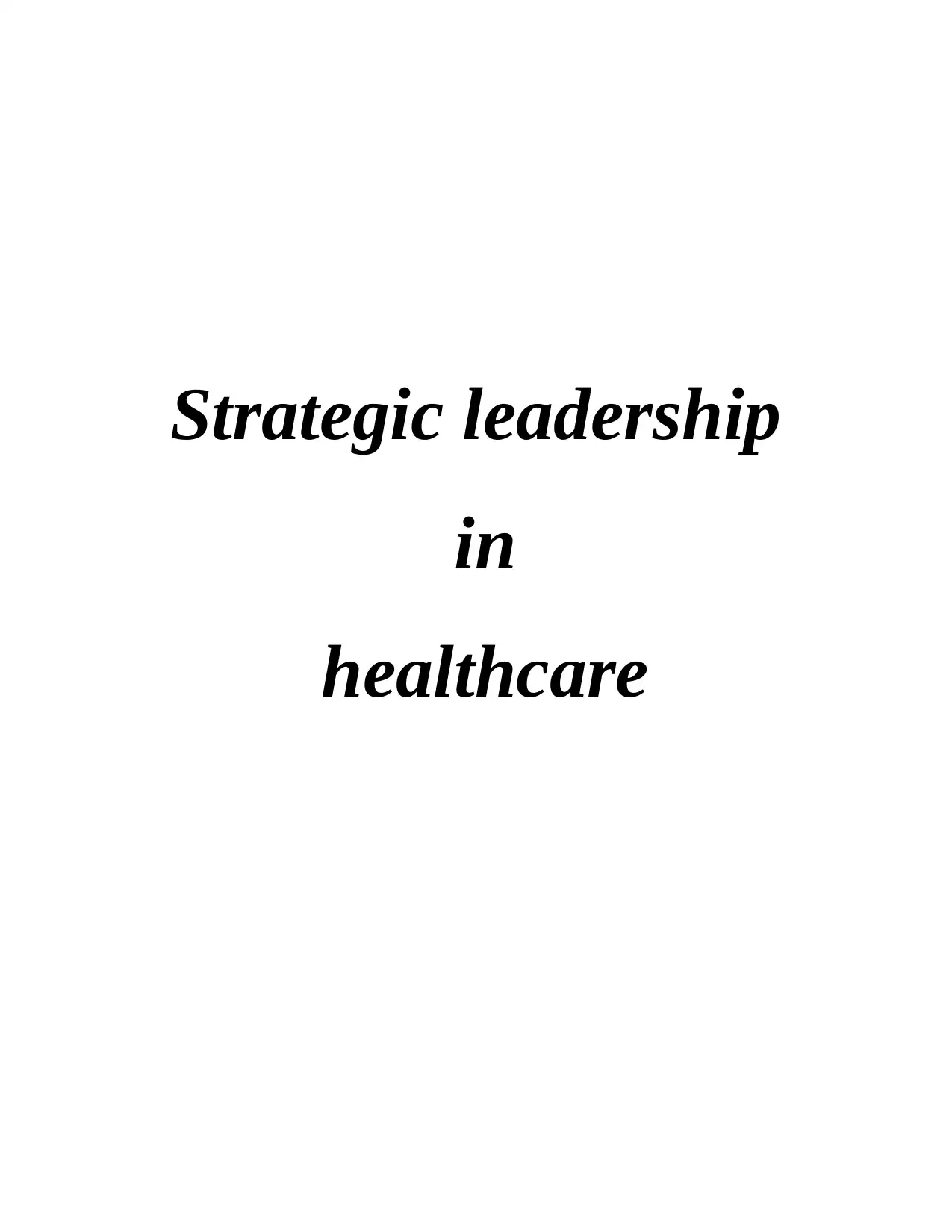
Strategic leadership
in
healthcare
in
healthcare
Paraphrase This Document
Need a fresh take? Get an instant paraphrase of this document with our AI Paraphraser
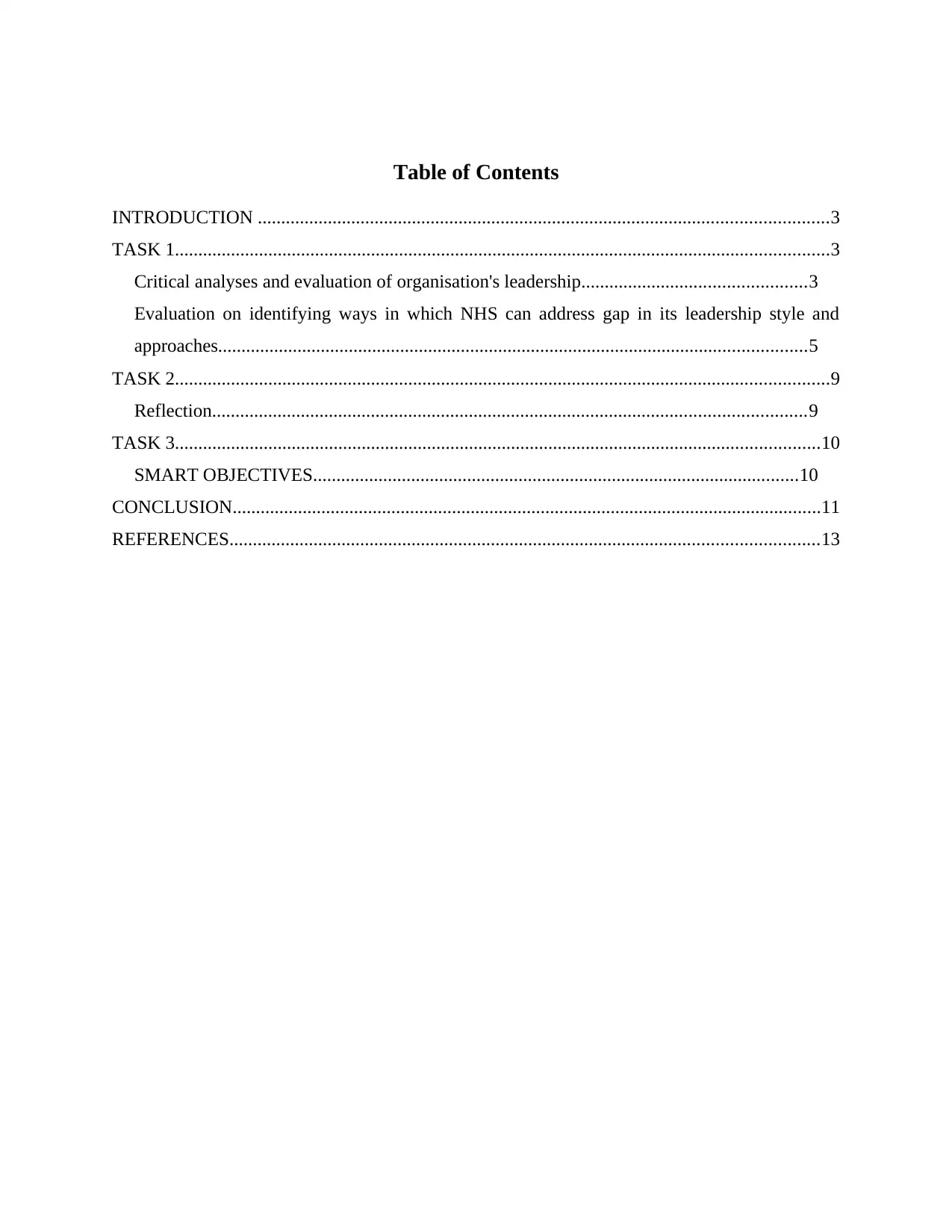
Table of Contents
INTRODUCTION ..........................................................................................................................3
TASK 1............................................................................................................................................3
Critical analyses and evaluation of organisation's leadership................................................3
Evaluation on identifying ways in which NHS can address gap in its leadership style and
approaches..............................................................................................................................5
TASK 2............................................................................................................................................9
Reflection...............................................................................................................................9
TASK 3..........................................................................................................................................10
SMART OBJECTIVES........................................................................................................10
CONCLUSION..............................................................................................................................11
REFERENCES..............................................................................................................................13
INTRODUCTION ..........................................................................................................................3
TASK 1............................................................................................................................................3
Critical analyses and evaluation of organisation's leadership................................................3
Evaluation on identifying ways in which NHS can address gap in its leadership style and
approaches..............................................................................................................................5
TASK 2............................................................................................................................................9
Reflection...............................................................................................................................9
TASK 3..........................................................................................................................................10
SMART OBJECTIVES........................................................................................................10
CONCLUSION..............................................................................................................................11
REFERENCES..............................................................................................................................13
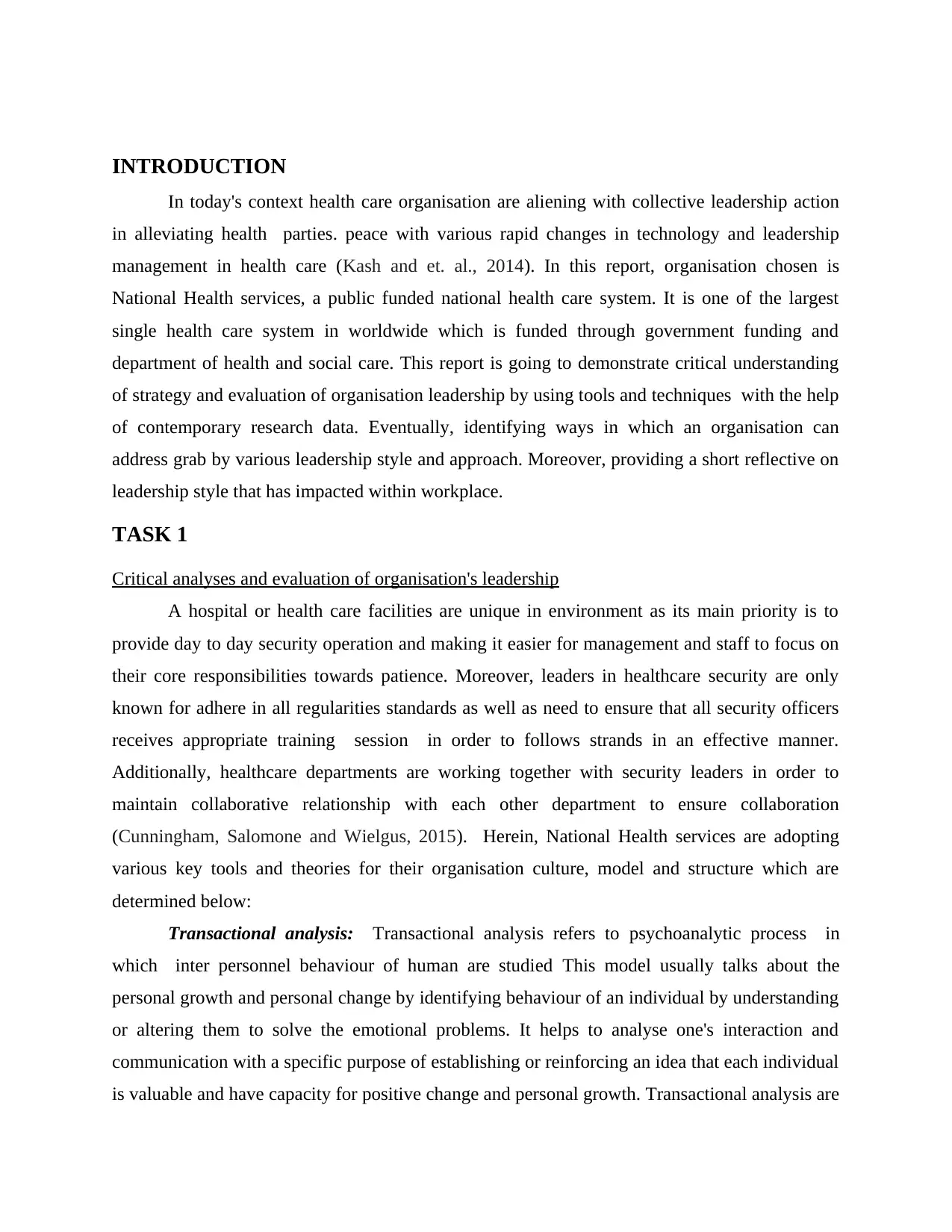
INTRODUCTION
In today's context health care organisation are aliening with collective leadership action
in alleviating health parties. peace with various rapid changes in technology and leadership
management in health care (Kash and et. al., 2014). In this report, organisation chosen is
National Health services, a public funded national health care system. It is one of the largest
single health care system in worldwide which is funded through government funding and
department of health and social care. This report is going to demonstrate critical understanding
of strategy and evaluation of organisation leadership by using tools and techniques with the help
of contemporary research data. Eventually, identifying ways in which an organisation can
address grab by various leadership style and approach. Moreover, providing a short reflective on
leadership style that has impacted within workplace.
TASK 1
Critical analyses and evaluation of organisation's leadership
A hospital or health care facilities are unique in environment as its main priority is to
provide day to day security operation and making it easier for management and staff to focus on
their core responsibilities towards patience. Moreover, leaders in healthcare security are only
known for adhere in all regularities standards as well as need to ensure that all security officers
receives appropriate training session in order to follows strands in an effective manner.
Additionally, healthcare departments are working together with security leaders in order to
maintain collaborative relationship with each other department to ensure collaboration
(Cunningham, Salomone and Wielgus, 2015). Herein, National Health services are adopting
various key tools and theories for their organisation culture, model and structure which are
determined below:
Transactional analysis: Transactional analysis refers to psychoanalytic process in
which inter personnel behaviour of human are studied This model usually talks about the
personal growth and personal change by identifying behaviour of an individual by understanding
or altering them to solve the emotional problems. It helps to analyse one's interaction and
communication with a specific purpose of establishing or reinforcing an idea that each individual
is valuable and have capacity for positive change and personal growth. Transactional analysis are
In today's context health care organisation are aliening with collective leadership action
in alleviating health parties. peace with various rapid changes in technology and leadership
management in health care (Kash and et. al., 2014). In this report, organisation chosen is
National Health services, a public funded national health care system. It is one of the largest
single health care system in worldwide which is funded through government funding and
department of health and social care. This report is going to demonstrate critical understanding
of strategy and evaluation of organisation leadership by using tools and techniques with the help
of contemporary research data. Eventually, identifying ways in which an organisation can
address grab by various leadership style and approach. Moreover, providing a short reflective on
leadership style that has impacted within workplace.
TASK 1
Critical analyses and evaluation of organisation's leadership
A hospital or health care facilities are unique in environment as its main priority is to
provide day to day security operation and making it easier for management and staff to focus on
their core responsibilities towards patience. Moreover, leaders in healthcare security are only
known for adhere in all regularities standards as well as need to ensure that all security officers
receives appropriate training session in order to follows strands in an effective manner.
Additionally, healthcare departments are working together with security leaders in order to
maintain collaborative relationship with each other department to ensure collaboration
(Cunningham, Salomone and Wielgus, 2015). Herein, National Health services are adopting
various key tools and theories for their organisation culture, model and structure which are
determined below:
Transactional analysis: Transactional analysis refers to psychoanalytic process in
which inter personnel behaviour of human are studied This model usually talks about the
personal growth and personal change by identifying behaviour of an individual by understanding
or altering them to solve the emotional problems. It helps to analyse one's interaction and
communication with a specific purpose of establishing or reinforcing an idea that each individual
is valuable and have capacity for positive change and personal growth. Transactional analysis are
⊘ This is a preview!⊘
Do you want full access?
Subscribe today to unlock all pages.

Trusted by 1+ million students worldwide
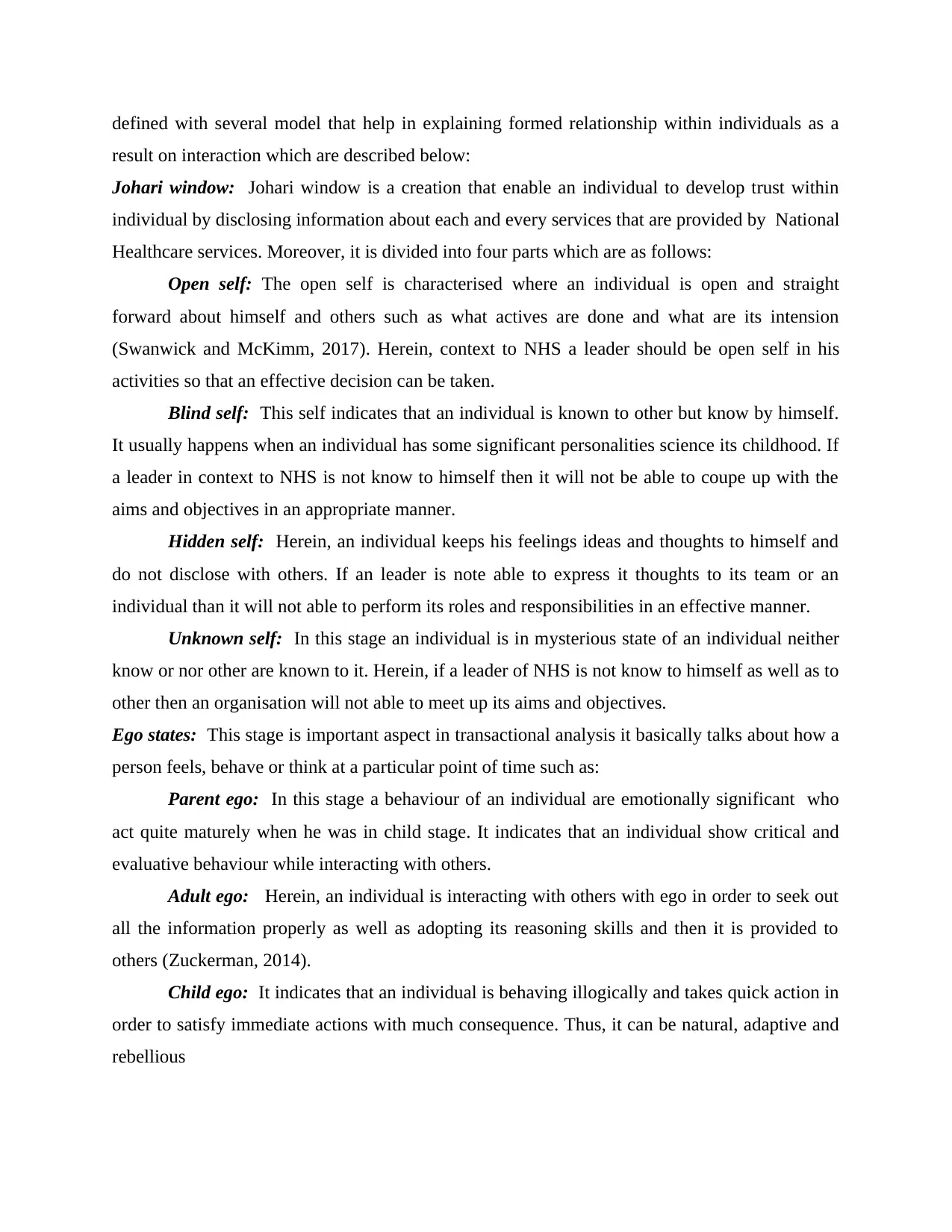
defined with several model that help in explaining formed relationship within individuals as a
result on interaction which are described below:
Johari window: Johari window is a creation that enable an individual to develop trust within
individual by disclosing information about each and every services that are provided by National
Healthcare services. Moreover, it is divided into four parts which are as follows:
Open self: The open self is characterised where an individual is open and straight
forward about himself and others such as what actives are done and what are its intension
(Swanwick and McKimm, 2017). Herein, context to NHS a leader should be open self in his
activities so that an effective decision can be taken.
Blind self: This self indicates that an individual is known to other but know by himself.
It usually happens when an individual has some significant personalities science its childhood. If
a leader in context to NHS is not know to himself then it will not be able to coupe up with the
aims and objectives in an appropriate manner.
Hidden self: Herein, an individual keeps his feelings ideas and thoughts to himself and
do not disclose with others. If an leader is note able to express it thoughts to its team or an
individual than it will not able to perform its roles and responsibilities in an effective manner.
Unknown self: In this stage an individual is in mysterious state of an individual neither
know or nor other are known to it. Herein, if a leader of NHS is not know to himself as well as to
other then an organisation will not able to meet up its aims and objectives.
Ego states: This stage is important aspect in transactional analysis it basically talks about how a
person feels, behave or think at a particular point of time such as:
Parent ego: In this stage a behaviour of an individual are emotionally significant who
act quite maturely when he was in child stage. It indicates that an individual show critical and
evaluative behaviour while interacting with others.
Adult ego: Herein, an individual is interacting with others with ego in order to seek out
all the information properly as well as adopting its reasoning skills and then it is provided to
others (Zuckerman, 2014).
Child ego: It indicates that an individual is behaving illogically and takes quick action in
order to satisfy immediate actions with much consequence. Thus, it can be natural, adaptive and
rebellious
result on interaction which are described below:
Johari window: Johari window is a creation that enable an individual to develop trust within
individual by disclosing information about each and every services that are provided by National
Healthcare services. Moreover, it is divided into four parts which are as follows:
Open self: The open self is characterised where an individual is open and straight
forward about himself and others such as what actives are done and what are its intension
(Swanwick and McKimm, 2017). Herein, context to NHS a leader should be open self in his
activities so that an effective decision can be taken.
Blind self: This self indicates that an individual is known to other but know by himself.
It usually happens when an individual has some significant personalities science its childhood. If
a leader in context to NHS is not know to himself then it will not be able to coupe up with the
aims and objectives in an appropriate manner.
Hidden self: Herein, an individual keeps his feelings ideas and thoughts to himself and
do not disclose with others. If an leader is note able to express it thoughts to its team or an
individual than it will not able to perform its roles and responsibilities in an effective manner.
Unknown self: In this stage an individual is in mysterious state of an individual neither
know or nor other are known to it. Herein, if a leader of NHS is not know to himself as well as to
other then an organisation will not able to meet up its aims and objectives.
Ego states: This stage is important aspect in transactional analysis it basically talks about how a
person feels, behave or think at a particular point of time such as:
Parent ego: In this stage a behaviour of an individual are emotionally significant who
act quite maturely when he was in child stage. It indicates that an individual show critical and
evaluative behaviour while interacting with others.
Adult ego: Herein, an individual is interacting with others with ego in order to seek out
all the information properly as well as adopting its reasoning skills and then it is provided to
others (Zuckerman, 2014).
Child ego: It indicates that an individual is behaving illogically and takes quick action in
order to satisfy immediate actions with much consequence. Thus, it can be natural, adaptive and
rebellious
Paraphrase This Document
Need a fresh take? Get an instant paraphrase of this document with our AI Paraphraser
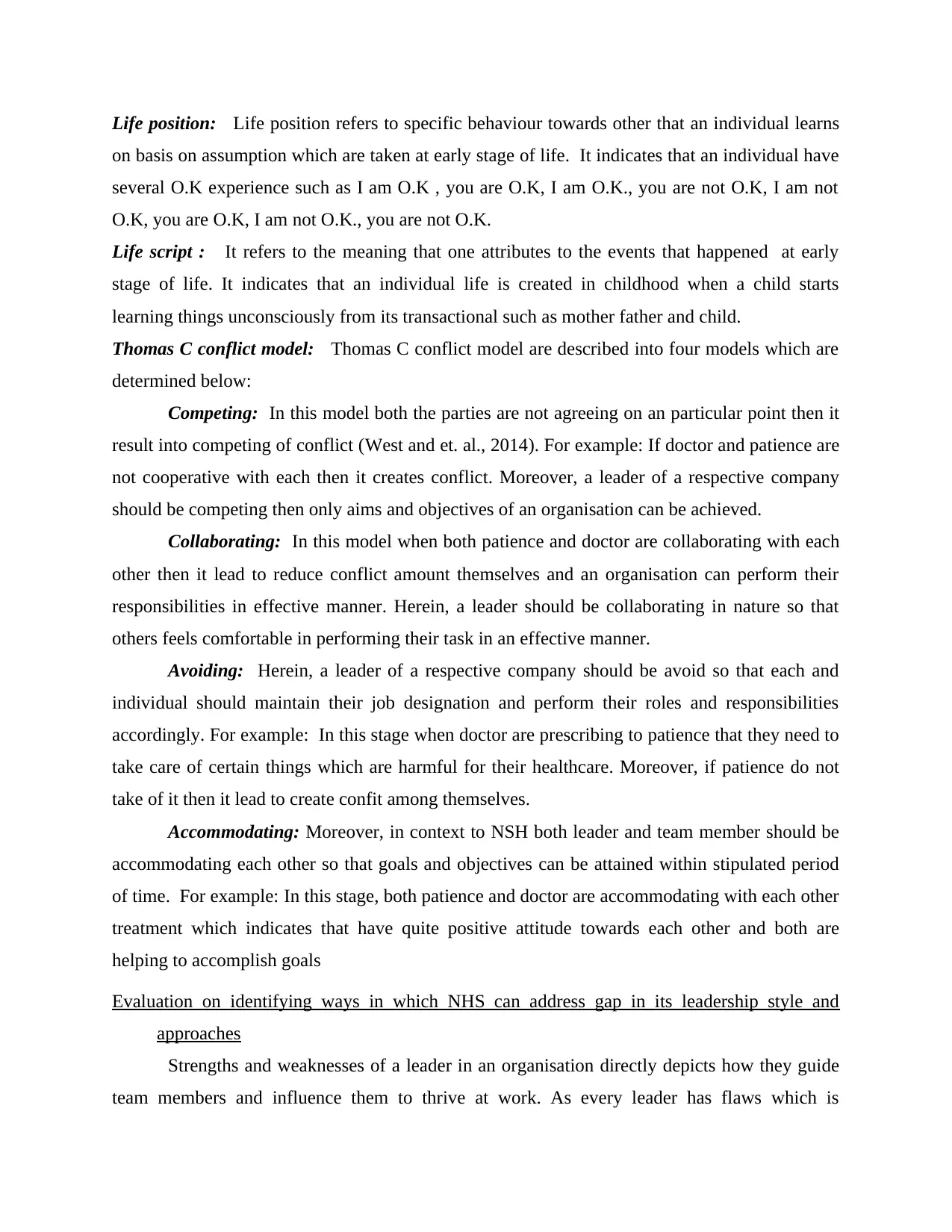
Life position: Life position refers to specific behaviour towards other that an individual learns
on basis on assumption which are taken at early stage of life. It indicates that an individual have
several O.K experience such as I am O.K , you are O.K, I am O.K., you are not O.K, I am not
O.K, you are O.K, I am not O.K., you are not O.K.
Life script : It refers to the meaning that one attributes to the events that happened at early
stage of life. It indicates that an individual life is created in childhood when a child starts
learning things unconsciously from its transactional such as mother father and child.
Thomas C conflict model: Thomas C conflict model are described into four models which are
determined below:
Competing: In this model both the parties are not agreeing on an particular point then it
result into competing of conflict (West and et. al., 2014). For example: If doctor and patience are
not cooperative with each then it creates conflict. Moreover, a leader of a respective company
should be competing then only aims and objectives of an organisation can be achieved.
Collaborating: In this model when both patience and doctor are collaborating with each
other then it lead to reduce conflict amount themselves and an organisation can perform their
responsibilities in effective manner. Herein, a leader should be collaborating in nature so that
others feels comfortable in performing their task in an effective manner.
Avoiding: Herein, a leader of a respective company should be avoid so that each and
individual should maintain their job designation and perform their roles and responsibilities
accordingly. For example: In this stage when doctor are prescribing to patience that they need to
take care of certain things which are harmful for their healthcare. Moreover, if patience do not
take of it then it lead to create confit among themselves.
Accommodating: Moreover, in context to NSH both leader and team member should be
accommodating each other so that goals and objectives can be attained within stipulated period
of time. For example: In this stage, both patience and doctor are accommodating with each other
treatment which indicates that have quite positive attitude towards each other and both are
helping to accomplish goals
Evaluation on identifying ways in which NHS can address gap in its leadership style and
approaches
Strengths and weaknesses of a leader in an organisation directly depicts how they guide
team members and influence them to thrive at work. As every leader has flaws which is
on basis on assumption which are taken at early stage of life. It indicates that an individual have
several O.K experience such as I am O.K , you are O.K, I am O.K., you are not O.K, I am not
O.K, you are O.K, I am not O.K., you are not O.K.
Life script : It refers to the meaning that one attributes to the events that happened at early
stage of life. It indicates that an individual life is created in childhood when a child starts
learning things unconsciously from its transactional such as mother father and child.
Thomas C conflict model: Thomas C conflict model are described into four models which are
determined below:
Competing: In this model both the parties are not agreeing on an particular point then it
result into competing of conflict (West and et. al., 2014). For example: If doctor and patience are
not cooperative with each then it creates conflict. Moreover, a leader of a respective company
should be competing then only aims and objectives of an organisation can be achieved.
Collaborating: In this model when both patience and doctor are collaborating with each
other then it lead to reduce conflict amount themselves and an organisation can perform their
responsibilities in effective manner. Herein, a leader should be collaborating in nature so that
others feels comfortable in performing their task in an effective manner.
Avoiding: Herein, a leader of a respective company should be avoid so that each and
individual should maintain their job designation and perform their roles and responsibilities
accordingly. For example: In this stage when doctor are prescribing to patience that they need to
take care of certain things which are harmful for their healthcare. Moreover, if patience do not
take of it then it lead to create confit among themselves.
Accommodating: Moreover, in context to NSH both leader and team member should be
accommodating each other so that goals and objectives can be attained within stipulated period
of time. For example: In this stage, both patience and doctor are accommodating with each other
treatment which indicates that have quite positive attitude towards each other and both are
helping to accomplish goals
Evaluation on identifying ways in which NHS can address gap in its leadership style and
approaches
Strengths and weaknesses of a leader in an organisation directly depicts how they guide
team members and influence them to thrive at work. As every leader has flaws which is
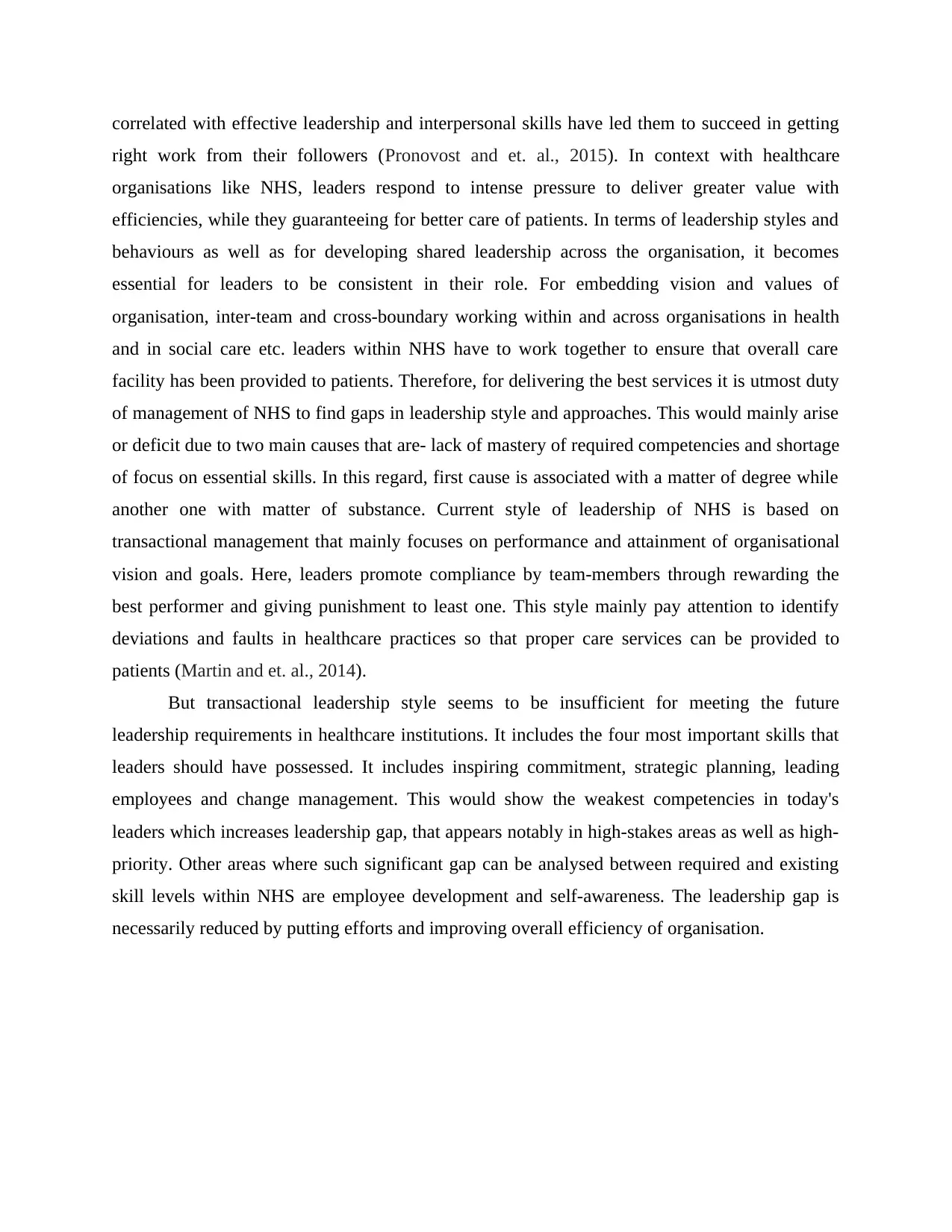
correlated with effective leadership and interpersonal skills have led them to succeed in getting
right work from their followers (Pronovost and et. al., 2015). In context with healthcare
organisations like NHS, leaders respond to intense pressure to deliver greater value with
efficiencies, while they guaranteeing for better care of patients. In terms of leadership styles and
behaviours as well as for developing shared leadership across the organisation, it becomes
essential for leaders to be consistent in their role. For embedding vision and values of
organisation, inter-team and cross-boundary working within and across organisations in health
and in social care etc. leaders within NHS have to work together to ensure that overall care
facility has been provided to patients. Therefore, for delivering the best services it is utmost duty
of management of NHS to find gaps in leadership style and approaches. This would mainly arise
or deficit due to two main causes that are- lack of mastery of required competencies and shortage
of focus on essential skills. In this regard, first cause is associated with a matter of degree while
another one with matter of substance. Current style of leadership of NHS is based on
transactional management that mainly focuses on performance and attainment of organisational
vision and goals. Here, leaders promote compliance by team-members through rewarding the
best performer and giving punishment to least one. This style mainly pay attention to identify
deviations and faults in healthcare practices so that proper care services can be provided to
patients (Martin and et. al., 2014).
But transactional leadership style seems to be insufficient for meeting the future
leadership requirements in healthcare institutions. It includes the four most important skills that
leaders should have possessed. It includes inspiring commitment, strategic planning, leading
employees and change management. This would show the weakest competencies in today's
leaders which increases leadership gap, that appears notably in high-stakes areas as well as high-
priority. Other areas where such significant gap can be analysed between required and existing
skill levels within NHS are employee development and self-awareness. The leadership gap is
necessarily reduced by putting efforts and improving overall efficiency of organisation.
right work from their followers (Pronovost and et. al., 2015). In context with healthcare
organisations like NHS, leaders respond to intense pressure to deliver greater value with
efficiencies, while they guaranteeing for better care of patients. In terms of leadership styles and
behaviours as well as for developing shared leadership across the organisation, it becomes
essential for leaders to be consistent in their role. For embedding vision and values of
organisation, inter-team and cross-boundary working within and across organisations in health
and in social care etc. leaders within NHS have to work together to ensure that overall care
facility has been provided to patients. Therefore, for delivering the best services it is utmost duty
of management of NHS to find gaps in leadership style and approaches. This would mainly arise
or deficit due to two main causes that are- lack of mastery of required competencies and shortage
of focus on essential skills. In this regard, first cause is associated with a matter of degree while
another one with matter of substance. Current style of leadership of NHS is based on
transactional management that mainly focuses on performance and attainment of organisational
vision and goals. Here, leaders promote compliance by team-members through rewarding the
best performer and giving punishment to least one. This style mainly pay attention to identify
deviations and faults in healthcare practices so that proper care services can be provided to
patients (Martin and et. al., 2014).
But transactional leadership style seems to be insufficient for meeting the future
leadership requirements in healthcare institutions. It includes the four most important skills that
leaders should have possessed. It includes inspiring commitment, strategic planning, leading
employees and change management. This would show the weakest competencies in today's
leaders which increases leadership gap, that appears notably in high-stakes areas as well as high-
priority. Other areas where such significant gap can be analysed between required and existing
skill levels within NHS are employee development and self-awareness. The leadership gap is
necessarily reduced by putting efforts and improving overall efficiency of organisation.
⊘ This is a preview!⊘
Do you want full access?
Subscribe today to unlock all pages.

Trusted by 1+ million students worldwide
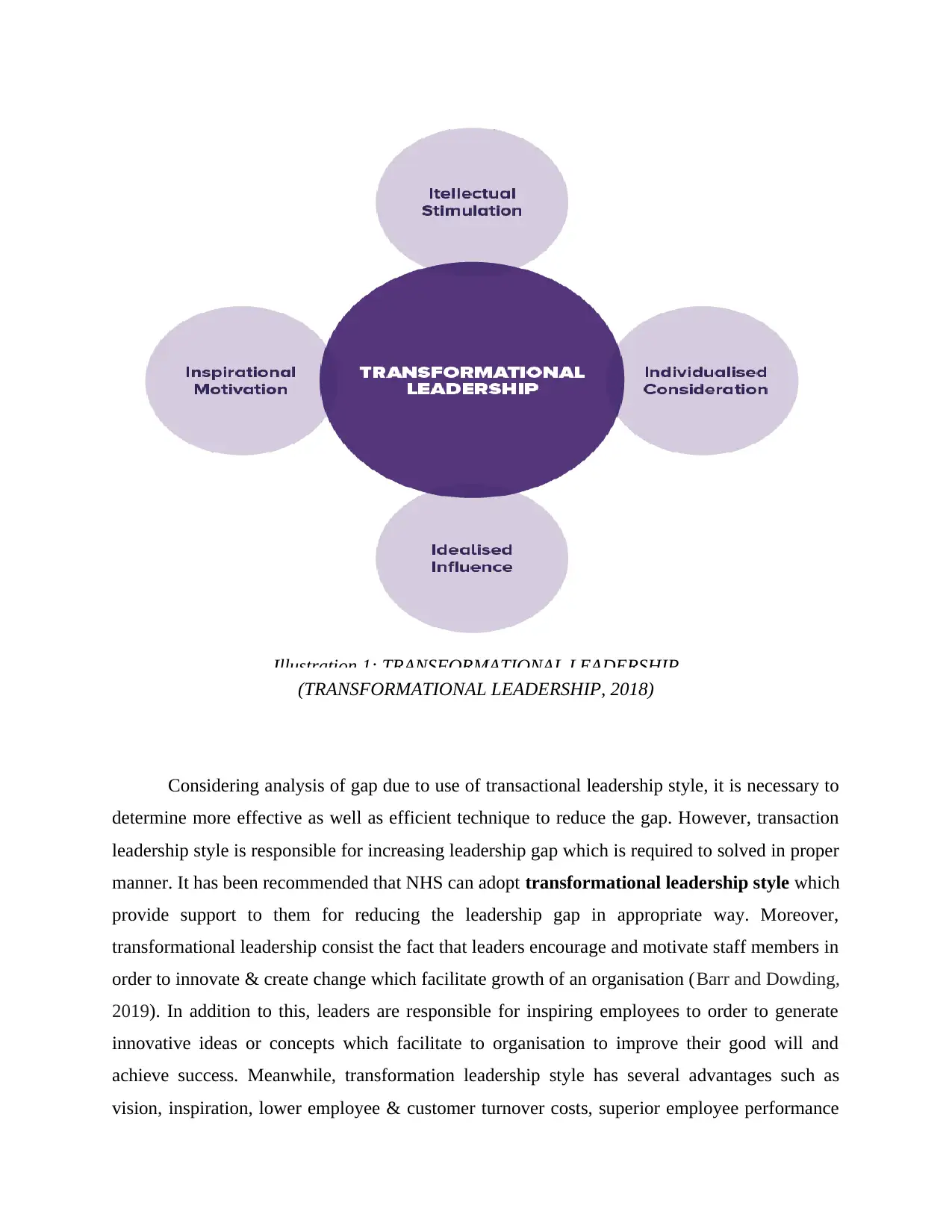
(TRANSFORMATIONAL LEADERSHIP, 2018)
Considering analysis of gap due to use of transactional leadership style, it is necessary to
determine more effective as well as efficient technique to reduce the gap. However, transaction
leadership style is responsible for increasing leadership gap which is required to solved in proper
manner. It has been recommended that NHS can adopt transformational leadership style which
provide support to them for reducing the leadership gap in appropriate way. Moreover,
transformational leadership consist the fact that leaders encourage and motivate staff members in
order to innovate & create change which facilitate growth of an organisation (Barr and Dowding,
2019). In addition to this, leaders are responsible for inspiring employees to order to generate
innovative ideas or concepts which facilitate to organisation to improve their good will and
achieve success. Meanwhile, transformation leadership style has several advantages such as
vision, inspiration, lower employee & customer turnover costs, superior employee performance
Illustration 1: TRANSFORMATIONAL LEADERSHIP
Considering analysis of gap due to use of transactional leadership style, it is necessary to
determine more effective as well as efficient technique to reduce the gap. However, transaction
leadership style is responsible for increasing leadership gap which is required to solved in proper
manner. It has been recommended that NHS can adopt transformational leadership style which
provide support to them for reducing the leadership gap in appropriate way. Moreover,
transformational leadership consist the fact that leaders encourage and motivate staff members in
order to innovate & create change which facilitate growth of an organisation (Barr and Dowding,
2019). In addition to this, leaders are responsible for inspiring employees to order to generate
innovative ideas or concepts which facilitate to organisation to improve their good will and
achieve success. Meanwhile, transformation leadership style has several advantages such as
vision, inspiration, lower employee & customer turnover costs, superior employee performance
Illustration 1: TRANSFORMATIONAL LEADERSHIP
Paraphrase This Document
Need a fresh take? Get an instant paraphrase of this document with our AI Paraphraser
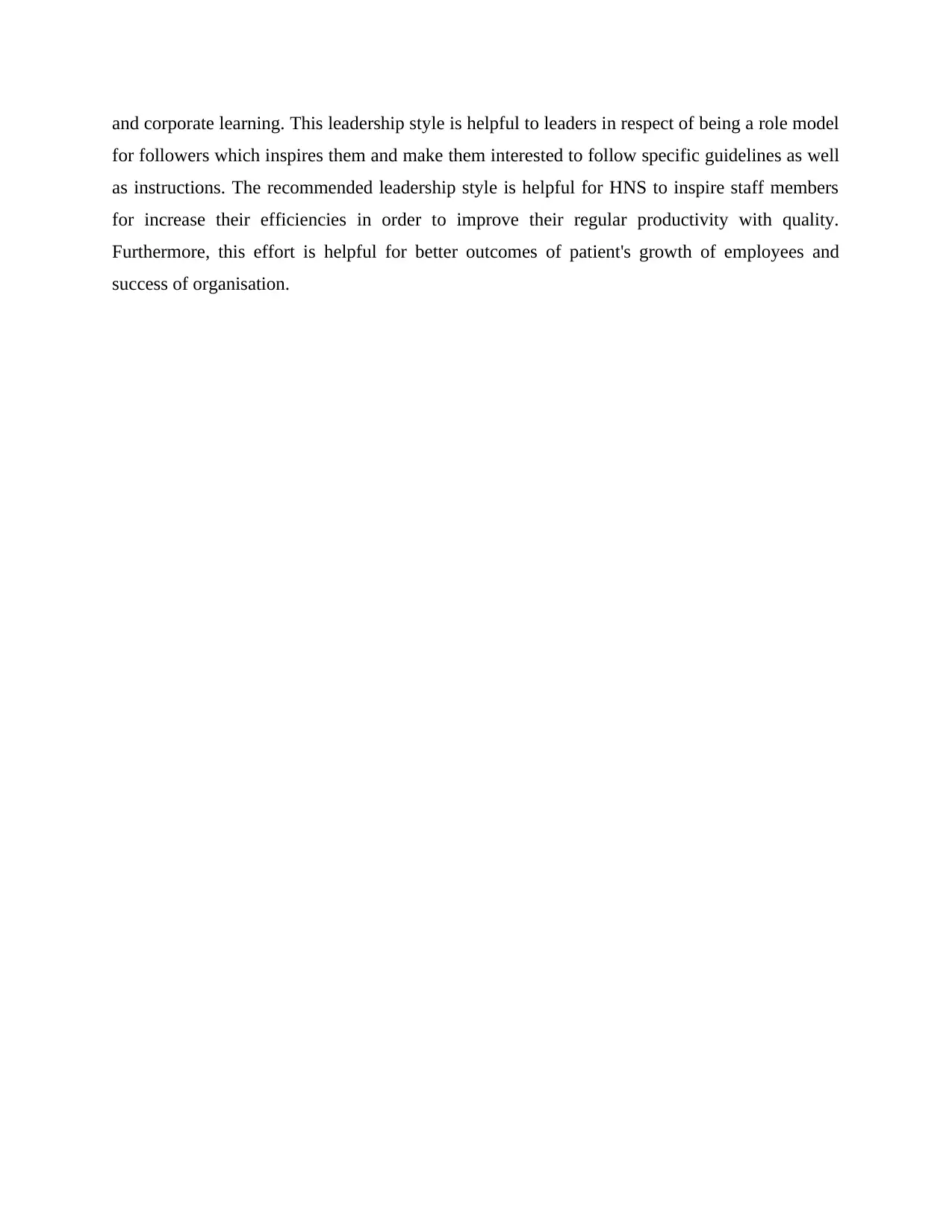
and corporate learning. This leadership style is helpful to leaders in respect of being a role model
for followers which inspires them and make them interested to follow specific guidelines as well
as instructions. The recommended leadership style is helpful for HNS to inspire staff members
for increase their efficiencies in order to improve their regular productivity with quality.
Furthermore, this effort is helpful for better outcomes of patient's growth of employees and
success of organisation.
for followers which inspires them and make them interested to follow specific guidelines as well
as instructions. The recommended leadership style is helpful for HNS to inspire staff members
for increase their efficiencies in order to improve their regular productivity with quality.
Furthermore, this effort is helpful for better outcomes of patient's growth of employees and
success of organisation.
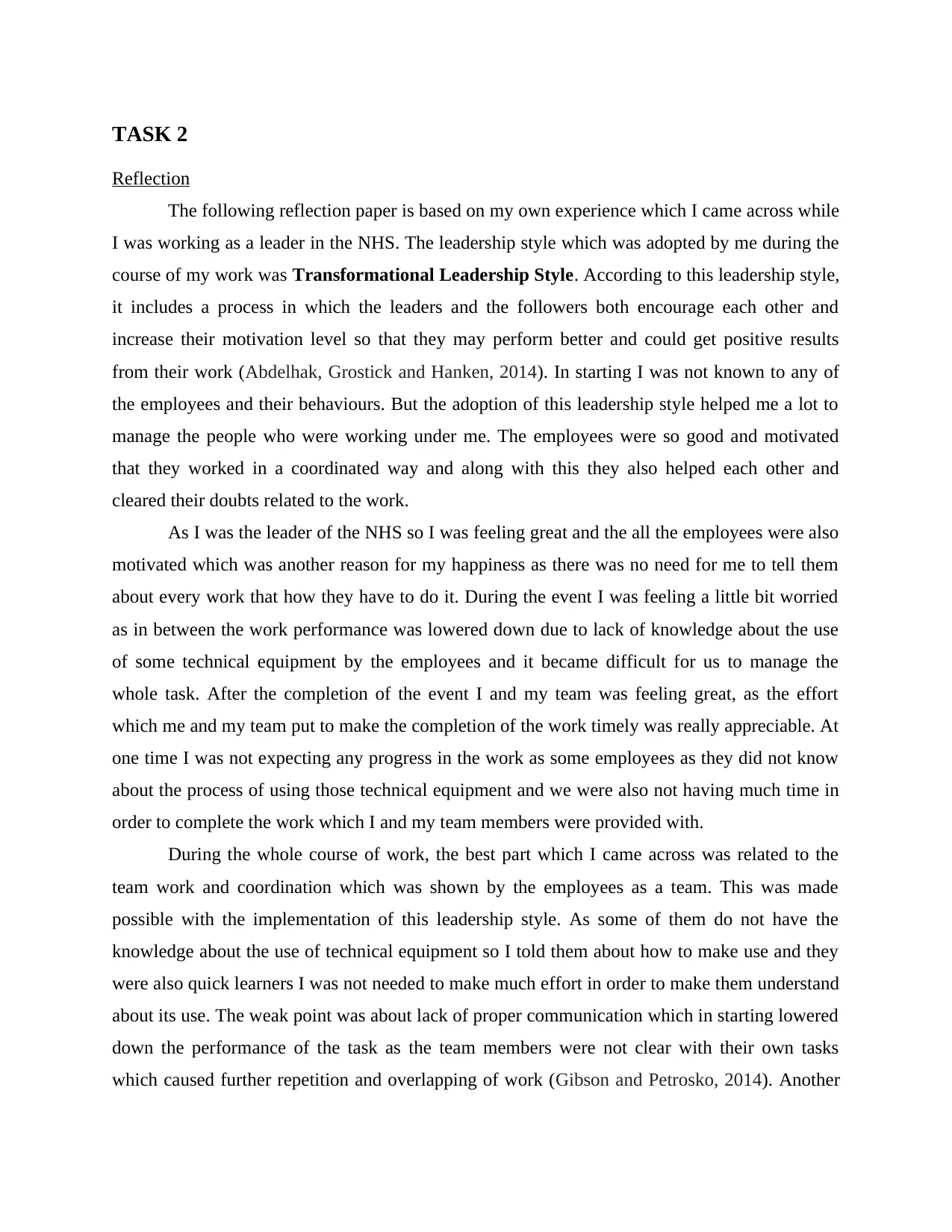
TASK 2
Reflection
The following reflection paper is based on my own experience which I came across while
I was working as a leader in the NHS. The leadership style which was adopted by me during the
course of my work was Transformational Leadership Style. According to this leadership style,
it includes a process in which the leaders and the followers both encourage each other and
increase their motivation level so that they may perform better and could get positive results
from their work (Abdelhak, Grostick and Hanken, 2014). In starting I was not known to any of
the employees and their behaviours. But the adoption of this leadership style helped me a lot to
manage the people who were working under me. The employees were so good and motivated
that they worked in a coordinated way and along with this they also helped each other and
cleared their doubts related to the work.
As I was the leader of the NHS so I was feeling great and the all the employees were also
motivated which was another reason for my happiness as there was no need for me to tell them
about every work that how they have to do it. During the event I was feeling a little bit worried
as in between the work performance was lowered down due to lack of knowledge about the use
of some technical equipment by the employees and it became difficult for us to manage the
whole task. After the completion of the event I and my team was feeling great, as the effort
which me and my team put to make the completion of the work timely was really appreciable. At
one time I was not expecting any progress in the work as some employees as they did not know
about the process of using those technical equipment and we were also not having much time in
order to complete the work which I and my team members were provided with.
During the whole course of work, the best part which I came across was related to the
team work and coordination which was shown by the employees as a team. This was made
possible with the implementation of this leadership style. As some of them do not have the
knowledge about the use of technical equipment so I told them about how to make use and they
were also quick learners I was not needed to make much effort in order to make them understand
about its use. The weak point was about lack of proper communication which in starting lowered
down the performance of the task as the team members were not clear with their own tasks
which caused further repetition and overlapping of work (Gibson and Petrosko, 2014). Another
Reflection
The following reflection paper is based on my own experience which I came across while
I was working as a leader in the NHS. The leadership style which was adopted by me during the
course of my work was Transformational Leadership Style. According to this leadership style,
it includes a process in which the leaders and the followers both encourage each other and
increase their motivation level so that they may perform better and could get positive results
from their work (Abdelhak, Grostick and Hanken, 2014). In starting I was not known to any of
the employees and their behaviours. But the adoption of this leadership style helped me a lot to
manage the people who were working under me. The employees were so good and motivated
that they worked in a coordinated way and along with this they also helped each other and
cleared their doubts related to the work.
As I was the leader of the NHS so I was feeling great and the all the employees were also
motivated which was another reason for my happiness as there was no need for me to tell them
about every work that how they have to do it. During the event I was feeling a little bit worried
as in between the work performance was lowered down due to lack of knowledge about the use
of some technical equipment by the employees and it became difficult for us to manage the
whole task. After the completion of the event I and my team was feeling great, as the effort
which me and my team put to make the completion of the work timely was really appreciable. At
one time I was not expecting any progress in the work as some employees as they did not know
about the process of using those technical equipment and we were also not having much time in
order to complete the work which I and my team members were provided with.
During the whole course of work, the best part which I came across was related to the
team work and coordination which was shown by the employees as a team. This was made
possible with the implementation of this leadership style. As some of them do not have the
knowledge about the use of technical equipment so I told them about how to make use and they
were also quick learners I was not needed to make much effort in order to make them understand
about its use. The weak point was about lack of proper communication which in starting lowered
down the performance of the task as the team members were not clear with their own tasks
which caused further repetition and overlapping of work (Gibson and Petrosko, 2014). Another
⊘ This is a preview!⊘
Do you want full access?
Subscribe today to unlock all pages.

Trusted by 1+ million students worldwide
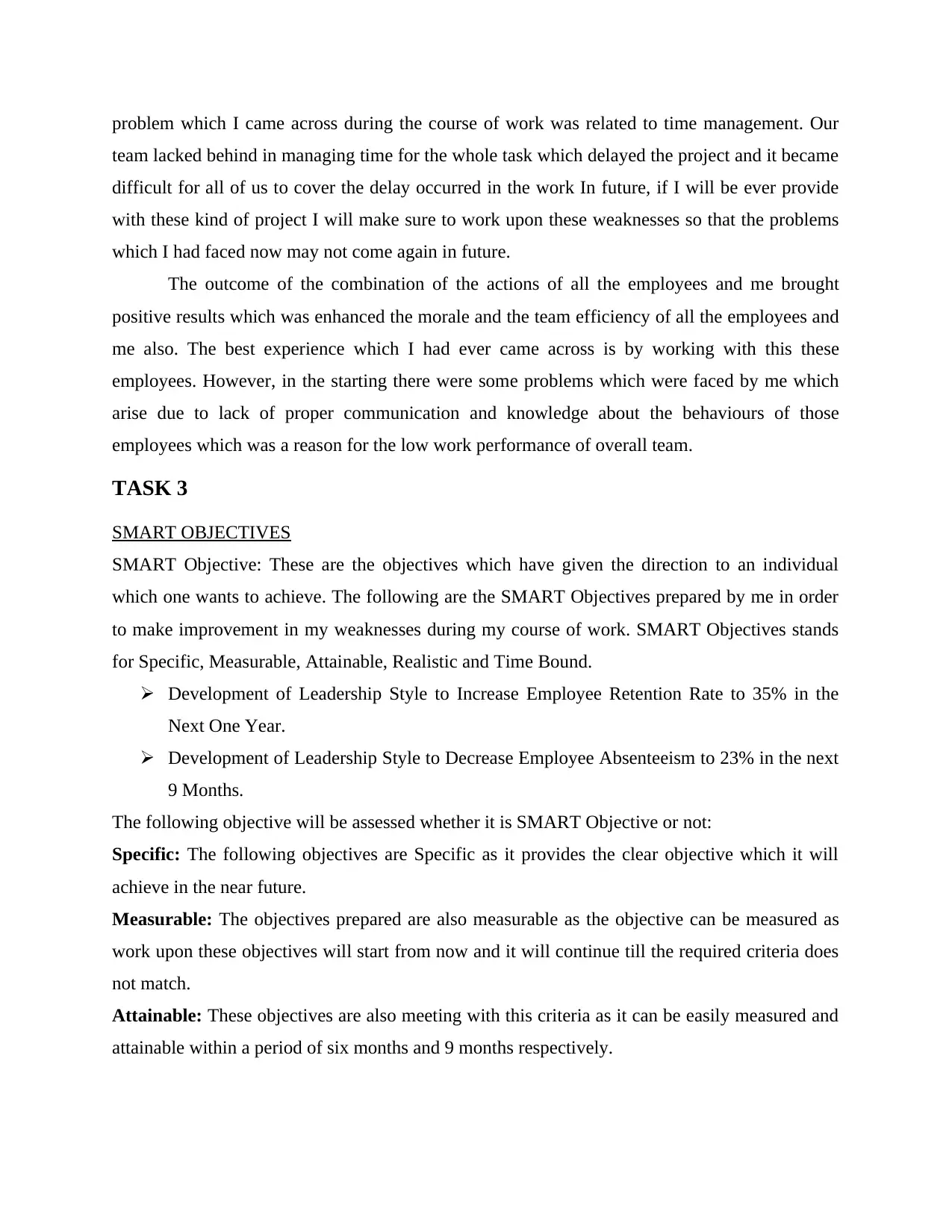
problem which I came across during the course of work was related to time management. Our
team lacked behind in managing time for the whole task which delayed the project and it became
difficult for all of us to cover the delay occurred in the work In future, if I will be ever provide
with these kind of project I will make sure to work upon these weaknesses so that the problems
which I had faced now may not come again in future.
The outcome of the combination of the actions of all the employees and me brought
positive results which was enhanced the morale and the team efficiency of all the employees and
me also. The best experience which I had ever came across is by working with this these
employees. However, in the starting there were some problems which were faced by me which
arise due to lack of proper communication and knowledge about the behaviours of those
employees which was a reason for the low work performance of overall team.
TASK 3
SMART OBJECTIVES
SMART Objective: These are the objectives which have given the direction to an individual
which one wants to achieve. The following are the SMART Objectives prepared by me in order
to make improvement in my weaknesses during my course of work. SMART Objectives stands
for Specific, Measurable, Attainable, Realistic and Time Bound.
Development of Leadership Style to Increase Employee Retention Rate to 35% in the
Next One Year.
Development of Leadership Style to Decrease Employee Absenteeism to 23% in the next
9 Months.
The following objective will be assessed whether it is SMART Objective or not:
Specific: The following objectives are Specific as it provides the clear objective which it will
achieve in the near future.
Measurable: The objectives prepared are also measurable as the objective can be measured as
work upon these objectives will start from now and it will continue till the required criteria does
not match.
Attainable: These objectives are also meeting with this criteria as it can be easily measured and
attainable within a period of six months and 9 months respectively.
team lacked behind in managing time for the whole task which delayed the project and it became
difficult for all of us to cover the delay occurred in the work In future, if I will be ever provide
with these kind of project I will make sure to work upon these weaknesses so that the problems
which I had faced now may not come again in future.
The outcome of the combination of the actions of all the employees and me brought
positive results which was enhanced the morale and the team efficiency of all the employees and
me also. The best experience which I had ever came across is by working with this these
employees. However, in the starting there were some problems which were faced by me which
arise due to lack of proper communication and knowledge about the behaviours of those
employees which was a reason for the low work performance of overall team.
TASK 3
SMART OBJECTIVES
SMART Objective: These are the objectives which have given the direction to an individual
which one wants to achieve. The following are the SMART Objectives prepared by me in order
to make improvement in my weaknesses during my course of work. SMART Objectives stands
for Specific, Measurable, Attainable, Realistic and Time Bound.
Development of Leadership Style to Increase Employee Retention Rate to 35% in the
Next One Year.
Development of Leadership Style to Decrease Employee Absenteeism to 23% in the next
9 Months.
The following objective will be assessed whether it is SMART Objective or not:
Specific: The following objectives are Specific as it provides the clear objective which it will
achieve in the near future.
Measurable: The objectives prepared are also measurable as the objective can be measured as
work upon these objectives will start from now and it will continue till the required criteria does
not match.
Attainable: These objectives are also meeting with this criteria as it can be easily measured and
attainable within a period of six months and 9 months respectively.
Paraphrase This Document
Need a fresh take? Get an instant paraphrase of this document with our AI Paraphraser
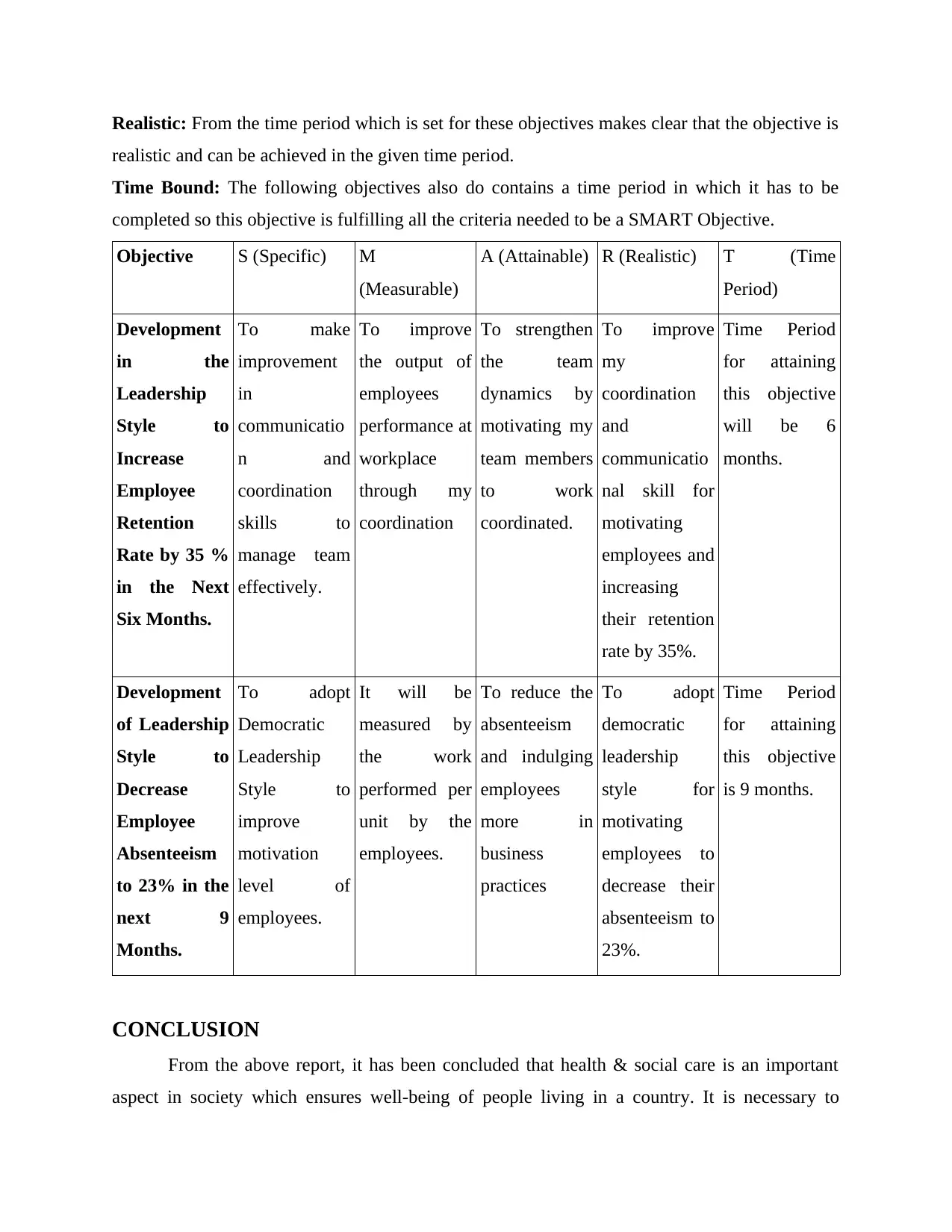
Realistic: From the time period which is set for these objectives makes clear that the objective is
realistic and can be achieved in the given time period.
Time Bound: The following objectives also do contains a time period in which it has to be
completed so this objective is fulfilling all the criteria needed to be a SMART Objective.
Objective S (Specific) M
(Measurable)
A (Attainable) R (Realistic) T (Time
Period)
Development
in the
Leadership
Style to
Increase
Employee
Retention
Rate by 35 %
in the Next
Six Months.
To make
improvement
in
communicatio
n and
coordination
skills to
manage team
effectively.
To improve
the output of
employees
performance at
workplace
through my
coordination
To strengthen
the team
dynamics by
motivating my
team members
to work
coordinated.
To improve
my
coordination
and
communicatio
nal skill for
motivating
employees and
increasing
their retention
rate by 35%.
Time Period
for attaining
this objective
will be 6
months.
Development
of Leadership
Style to
Decrease
Employee
Absenteeism
to 23% in the
next 9
Months.
To adopt
Democratic
Leadership
Style to
improve
motivation
level of
employees.
It will be
measured by
the work
performed per
unit by the
employees.
To reduce the
absenteeism
and indulging
employees
more in
business
practices
To adopt
democratic
leadership
style for
motivating
employees to
decrease their
absenteeism to
23%.
Time Period
for attaining
this objective
is 9 months.
CONCLUSION
From the above report, it has been concluded that health & social care is an important
aspect in society which ensures well-being of people living in a country. It is necessary to
realistic and can be achieved in the given time period.
Time Bound: The following objectives also do contains a time period in which it has to be
completed so this objective is fulfilling all the criteria needed to be a SMART Objective.
Objective S (Specific) M
(Measurable)
A (Attainable) R (Realistic) T (Time
Period)
Development
in the
Leadership
Style to
Increase
Employee
Retention
Rate by 35 %
in the Next
Six Months.
To make
improvement
in
communicatio
n and
coordination
skills to
manage team
effectively.
To improve
the output of
employees
performance at
workplace
through my
coordination
To strengthen
the team
dynamics by
motivating my
team members
to work
coordinated.
To improve
my
coordination
and
communicatio
nal skill for
motivating
employees and
increasing
their retention
rate by 35%.
Time Period
for attaining
this objective
will be 6
months.
Development
of Leadership
Style to
Decrease
Employee
Absenteeism
to 23% in the
next 9
Months.
To adopt
Democratic
Leadership
Style to
improve
motivation
level of
employees.
It will be
measured by
the work
performed per
unit by the
employees.
To reduce the
absenteeism
and indulging
employees
more in
business
practices
To adopt
democratic
leadership
style for
motivating
employees to
decrease their
absenteeism to
23%.
Time Period
for attaining
this objective
is 9 months.
CONCLUSION
From the above report, it has been concluded that health & social care is an important
aspect in society which ensures well-being of people living in a country. It is necessary to
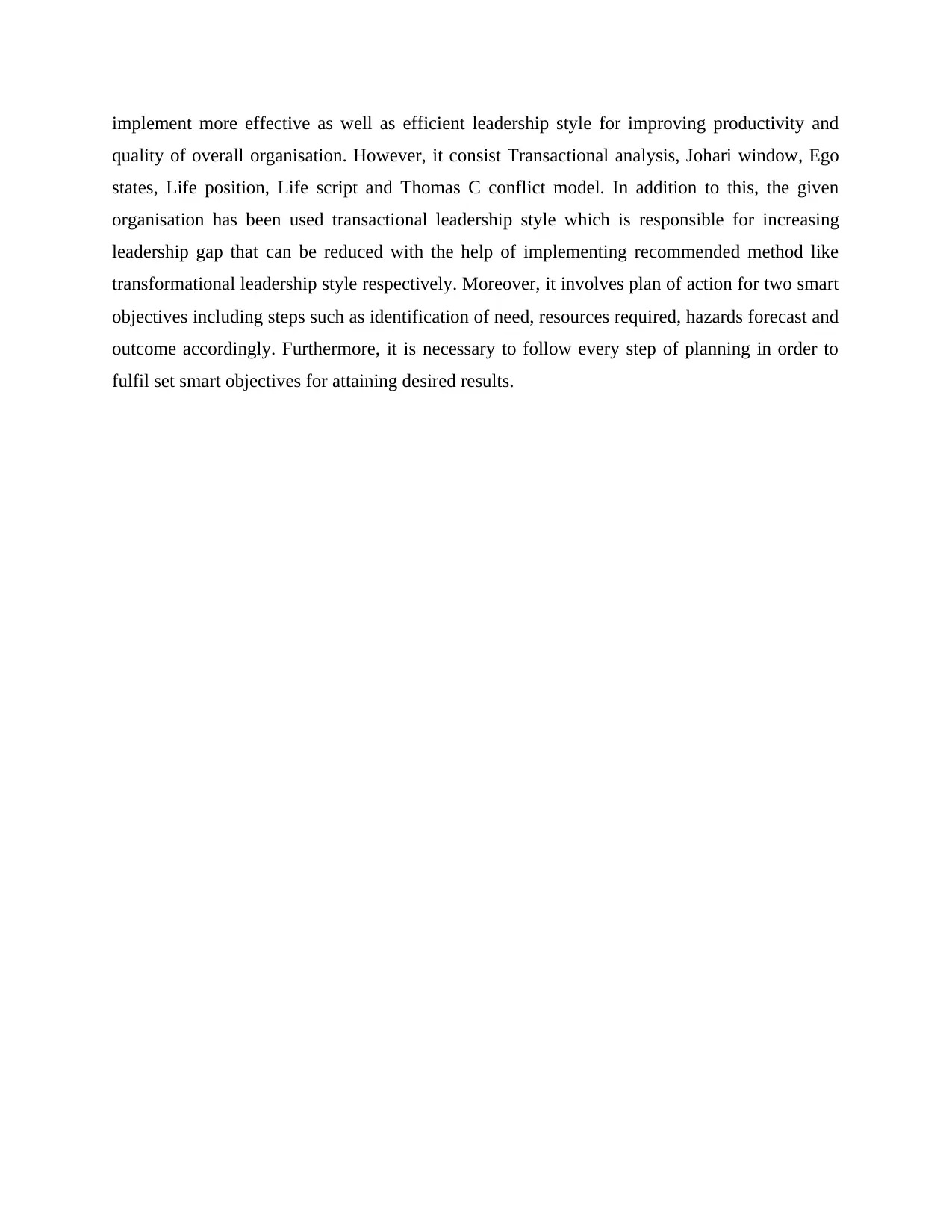
implement more effective as well as efficient leadership style for improving productivity and
quality of overall organisation. However, it consist Transactional analysis, Johari window, Ego
states, Life position, Life script and Thomas C conflict model. In addition to this, the given
organisation has been used transactional leadership style which is responsible for increasing
leadership gap that can be reduced with the help of implementing recommended method like
transformational leadership style respectively. Moreover, it involves plan of action for two smart
objectives including steps such as identification of need, resources required, hazards forecast and
outcome accordingly. Furthermore, it is necessary to follow every step of planning in order to
fulfil set smart objectives for attaining desired results.
quality of overall organisation. However, it consist Transactional analysis, Johari window, Ego
states, Life position, Life script and Thomas C conflict model. In addition to this, the given
organisation has been used transactional leadership style which is responsible for increasing
leadership gap that can be reduced with the help of implementing recommended method like
transformational leadership style respectively. Moreover, it involves plan of action for two smart
objectives including steps such as identification of need, resources required, hazards forecast and
outcome accordingly. Furthermore, it is necessary to follow every step of planning in order to
fulfil set smart objectives for attaining desired results.
⊘ This is a preview!⊘
Do you want full access?
Subscribe today to unlock all pages.

Trusted by 1+ million students worldwide
1 out of 13
Related Documents
Your All-in-One AI-Powered Toolkit for Academic Success.
+13062052269
info@desklib.com
Available 24*7 on WhatsApp / Email
![[object Object]](/_next/static/media/star-bottom.7253800d.svg)
Unlock your academic potential
Copyright © 2020–2025 A2Z Services. All Rights Reserved. Developed and managed by ZUCOL.





